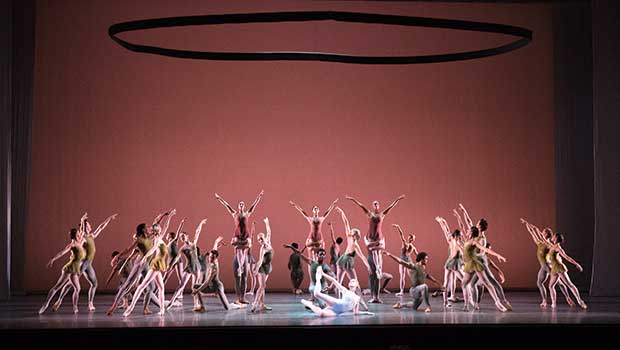Boston Ballet program reflects talents of Finland
Company to perform ‘Obsidian Tear’ and ‘Fifth Symphony of Jean Sibelius’

The Boston Ballet begins its 2017–2018 season with a majestic program that has Finland as its theme.
Coinciding with the 100th anniversary of Finnish independence from the giant at its border, Russia, the program presents the North American premiere of Wayne McGregor’s “Obsidian Tear” and the world premiere of Jorma Elo’s “Fifth Symphony of Jean Sibelius.”

Author: Rosalie O’Connor, courtesy Boston BalletBoston Ballet in Wayne McGregor’s “Obsidian Tear.”
Its focus reflects the talents and Finnish roots of two native sons within the Boston Ballet, Artistic Director Mikko Nissinen and Resident Choreographer Jorma Elo, as well as the gifts of two revered Finnish musicians, contemporary composer Esa-Pekka Salonen and Jean Sibelius (1865–1957), regarded as the father of Finnish music.
Finland is a small country in population — with less than six million people — but large in unspoiled geography of alpine tundra, forests and lakes, and at the top in global indices that track human rights, prosperity and quality of life.
The music of Salonen and Sibelius is ardently conducted and performed, with the superb Boston Ballet Orchestra led by guest conductor Daniel Stewart, musical director of the Santa Cruz Symphony, handpicked by Salonen for the premiere.
The program, on stage through Nov. 12 at the Boston Opera House, begins not with a dance performance, but instead, with a richly textured orchestral performance of “Finlandia,” (1900) a symphonic poem by Sibelius that evokes the landscape of Finland. A love song to a country in which individualism and collective good are hallowed values that coexist in harmony, the soaring symphonic poem has a hummable melody at its heart that has itself become a hymn.
The first of two ballets on the program is “Obsidian Tear,” a co-production with the Royal Ballet in London, where it received its world premiere on May 28, 2016. The Boston Ballet added another McGregor work, “Chroma,” to its repertoire in 2013, and its performances of the ballet that year and in 2015 won rave reviews.
The new ballet’s title evokes a black volcanic rock, obsidian, used in surgical tools for its hardness as a cutting instrument, and the dual meanings of “tear” — the act of ripping apart and the emotional release of tears. The rock’s lustrous black surface is echoed in the ballet’s black costumes and McGregor’s spare set, dominated by a black backdrop.
The nine men who perform “Obsidian Tear” wear costumes that bare their chests and arms. Eight wear black body suits chosen by Katie Shillingford. Only one is in different attire — wide-legged red pants in a vaguely Orientalist style that resemble the pantaloons worn by turbaned men in a European Romantic era painter’s image of a harem.
Deft lighting by Lucy Carter illuminates the floor as a white frame for the red and black palette of the costumes, and marks transitions between the two segments of the ballet by momentarily transforming the floor into a band of blue light.
The first segment is performed by two men, the dancer in red pants and another clad in black, to the haunting Salonen composition “Lachen verlernt,” a violin solo exquisitely played by Christine Vitale.
With pirouettes and leaps that are both lyrical and athletic, the man in black seems to court the man in red, whose solos convey a searching individuality with semi-ritualistic movements such as wide arcs and spirals. The two men circle one another, mirror one another’s movements, connect and separate, intertwine and then unwind with a fluidity that is marvelous to watch.
The lyrical and athletic blend of McGregor’s choreography continues in the second segment, in which the nine-man ensemble performs to Salonen’s “Nyx,” a symphonic composition with passages of clanging metal and ominous drum rolls inspired by its namesake, a Greek goddess of the night. Now the man in red becomes a character, a figure isolated, taunted and attacked. One dancer in black also emerges as a primary character, his costume’s black armband suggesting the traits of a Gestapo-type militant.
Although at moments verging on melodrama, the choreography mainly succeeds at distilling the primal power plays among humans as they bond, part, fight and compete in pairs, groups or packs; and renders these interactions in a ballet that is both disturbing and beautiful. The dancer in red is led up into a high point in the darkness, his back to the audience, and is hurled off. Among the remaining dancers, the push and pull for control escalates, until the dancer with the black armband also dives into darkness.
Bringing luminous joy to the stage is the finale, a world premiere of Elo’s “Fifth Symphony of Jean Sibelius,” performed to a beloved Sibelius composition, “Symphony No. 5 in E-flat major, Op. 82,” which, says Elo, is “like hearing your national anthem.”
Sibelius presented the completed symphony in 1919 to a newly independent Finland that had just elected its first president. Boston Ballet Orchestra’s rendering brings out the piece’s heroic brass passages and shimmering impressionistic evocation of Finland’s landscape, echoed in the earth tones of Yumiko Takeshima’s costumes, the radiant lighting by Mark Stanley, and Elo’s delicate but strong choreography, which with a quicksilver flow of angles and curves creates intricate lattices and recurring circular patterns, as if mimicking the formation of life itself on a cellular level. The sublime music fully inhabits the dancers’ bodies in this mesmerizing ballet.




![Banner [Virtual] Art Gallery](https://baystatebanner.com/wp-content/uploads/2024/04/NJ-H_1-713x848.jpg)

